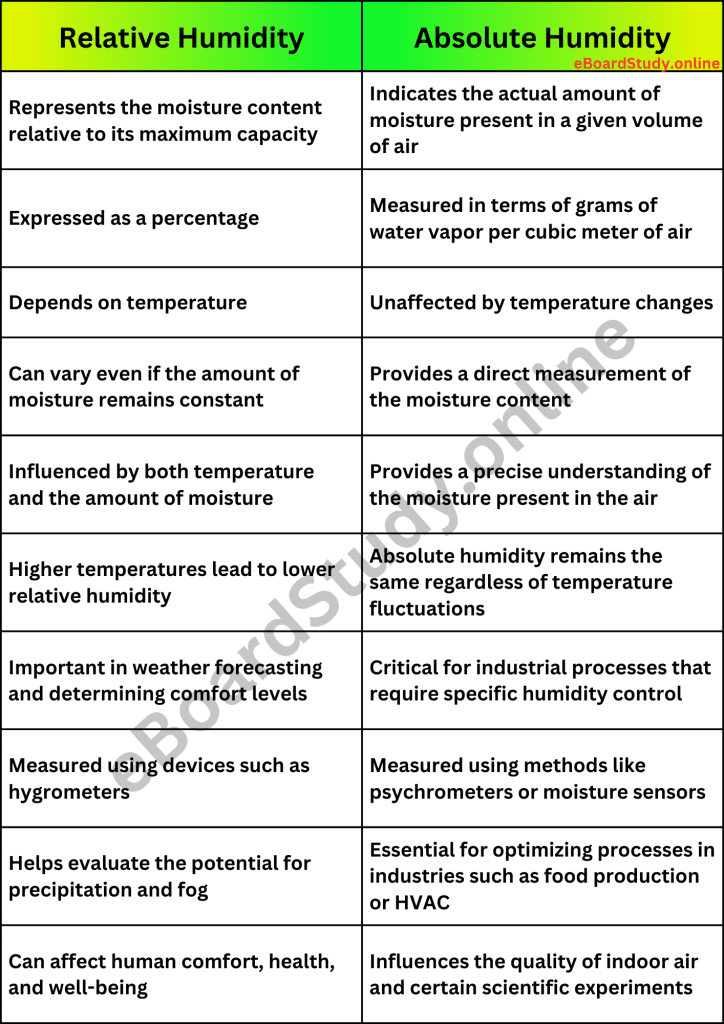Introduction
Humidity is a commonly used to describe the moisture in the air. It affects our comfort, health, and various aspects of our environment. Understanding the difference between relative and absolute humidity is crucial in comprehending how moisture behaves and its impact on different scenarios.
Difference between relative and absolute humidity [inTable].

What is the Differences Between Relative and Absolute Humidity
Differences Between Relative and Absolute Humidity
The key difference between relative and absolute humidity as given below :
Definition: Relative humidity compares the moisture content in the air to the maximum capacity at a specific temperature, while absolute humidity provides the actual amount of moisture present.
Temperature Dependence: Relative humidity changes with temperature, while absolute humidity remains unaffected by temperature variations.
Measurement Units: Relative moistness is communicated as a rate, while outright mugginess is regularly estimated in grams of water fume per cubic meter of air.
this is the some points of What is the difference between relative and absolute humidity.
Definition of Relative Humidity
The overall stickiness of the air can be determined by contrasting how much water in the air at a specific temperature. This is communicated as a rate. For instance, assuming the overall stickiness is half, this implies that the air holds back a portion of the greatest measure of water at that temperature. This estimation assists us with understanding the degree of moistness in the air and that it is so near immersion.
Definition of Absolute Humidity
Absolute humidity is a way to measure how much water is in the air. It tells us the actual amount of water present in amount of air. We measure it in grams of water fume per cubic meter of air. By knowing the absolute humidity, we can get a more accurate understanding of how much water vapor is in the air around us.
Importance of Understanding Humidity
Understanding humidity, both relative and absolute, is essential for various reasons:Comfort: Humidity levels significantly affect our comfort. humidity can make us feel sticky and uncomfortable, low humidity can cause dryness and discomfort in our skin and respiratory system.
Health: Humidity plays a role in our overall health. High humidity can contribute to the growth of mold and allergens, which can trigger respiratory issues. Low humidity can lead to dryness in our nasal passages and skin.
Indoor Air Quality: Maintaining optimal humidity levels in indoor spaces is vital for preserving air quality.Unnecessary moistness can encourage the development of form and microbes, while low mugginess can prompt an expansion in airborne particles like residue and allergens.
Agriculture: Understanding humidity is crucial in agriculture, as it affects crop growth and the health of plants. Different plants require specific humidity levels for optimal growth and yield.
Weather Forecasting: Meteorologists rely on humidity measurements to predict weather patterns, as humidity influences cloud formation, precipitation, and atmospheric stability.
FAQ
Why is humidity important?
Humidity affects our comfort, health, and the quality of our environment. Understanding humidity helps us make informed decisions and take appropriate measures.
What is absolute humidity used for?
Outright dampness is essential in different applications, including modern cycles, horticulture, and weather conditions estimating, where exact estimations of dampness content are required.
Can high humidity cause health issues?
High mugginess can add to the development of shape, allergens, and microscopic organisms, which can set off respiratory issues and inconvenience.
How does humidity affect electronics?
High mugginess levels can present dangers to electronic gadgets, as an overabundance of dampness in the air can prompt buildup and possible harm to delicate parts.

